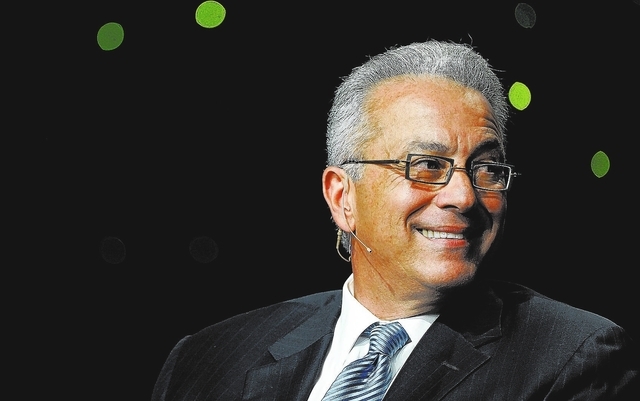Inside Gaming: Pinnacle CEO focuses on future

Pinnacle Entertainment CEO Anthony Sanfilippo drew as much attention during last week’s Global Gaming Expo as the Na’Vi warriors, zombies, Beetlejuice and David Copperfield.
Gaming equipment manufacturers and their newest slot machines based on feature films, television shows, pop culture and celebrities ruled the trade show floor of the Sands Expo and Convention Center.
But the regional gaming company, which doubled in size six weeks ago after completing its $2.8 billion buyout of rival Ameristar Casinos, also had star power.
On Monday, Sanfilippo took part in an investor breakfast organized by JP Morgan, participated in the Deutsche Bank/UBS investment forum, and had dinner with clients of Brean Capital. On Wednesday, Sanfilippo was on the panel for G2E’s State of the Industry Roundtable with four other gaming company CEOs.
Sanfilippo, however, was the main attraction.
“I feel very fortunate that we were able to marry a company that is so like our company,” said Sanfilippo, who has been Pinnacle’s CEO since March 2010. “We hit the markets at the right time and we hit the debt markets at the right time.”
Pinnacle’s buyout of Ameristar, which gave the Las Vegas-based company 15 casinos and racetrack casinos in nine states, marked the first large-scale gaming industry merger since the recession gripped the sector in 2008.
The transaction, announced last December, led to two additional high-profile mergers: lottery giant Scientific Games Corp.’s $1.5 billion purchase of slot machine maker WMS Industries and Bally Technologies’ $1.5 billion buyout of SHFL Entertainment.
With the ink dry for less than two months on the Pinnacle-Ameristar deal, Wall Street wants to know Sanfilippo’s next step.
The CEO, however, stayed on message.
Sanfilippo remains committed to achieving the previously announced $40 million in cost savings by bringing together the two companies. Two casino sales that were components of a consent package agreed upon with the Federal Trade Commission for the merger to happen are moving forward.
And a casino for slot machinelike video lottery terminals under construction at Pinnacle’s River Downs race track outside of Cincinnati is expected to be finished by next spring.
As for what’s next — a rumored purchase of a hotel-casino in Las Vegas or selling more property — Sanfilippo was being coy last week.
“We’re very much focused the successful merging of our two companies and that is our focus to make sure it’s done right,” Sanfilippo said.
Analysts are pleased with Pinnacle Entertainment’s direction.
Brean Capital gaming analyst Justin Sebastiano, who hosted the dinner with Sanfilippo and Vice President of Finance and Investor Relations Vincent Zahn, said the companies were in “integration mode” long before the deal closed.
The cost savings will come internally from eliminating redundant expenses and using the “best practices” from each company, such as Pinnacle adopting Ameristar’s accounting system.
“Management stated that the two corporate cultures have meshed well,” Sebastiano said. “Pinnacle selected the best people from both companies, not just legacy Pinnacle employees.”
Paying down debt, however, is foremost on the minds of most investors.
Pinnacle put a little more than $4 billion of long-term debt on the company’s books to complete the buyout. The figure is small by gaming industry comparisons — Caesars Entertainment Corp. carries a whopping $23.5 billion in long-term debt, followed closely by MGM Resorts International ($13 billion) and Las Vegas Sands Corp. ($9.49 billion).
Pinnacle will spend the next 12 to 18 months integrating Ameristar and removing some of the debt overhang.
“Beyond that time frame, management believes that other opportunities will present themselves and that by following the near-term strategy it will put itself in a position to take advantage of them when the time comes,” said JP Morgan gaming analyst Joe Greff, who hosted the breakfast with Sanfilippo, Zahn and CFO Carlos Ruisanchez.
Proceeds from selling Lumiere Place in St. Louis to Tropicana Entertainment for $260 million and parting with Ameristar’s development project in Lake Charles, La., under a structured transaction with Landry’s Restaurants will help pay down debt. Both deals should be done by early next year.
Pinnacle also told investors cash flow from casinos and the River Down expansion, which is adding nearly 1,300 VLTs and other amenities, will help the company reduce its debt-to-earnings ratios.
“Pinnacle remains committed to aggressively directing free cash flow towards debt pay down, something we believe will accrue meaningfully to equity holders,” Deutsche Bank gaming analyst Carlo Santerelli said. “While management noted that it would have liked to maintain ownership of (Lumiere Place and the Louisiana project), the sales do allow for faster debt pay down and deleveraging.”
But don’t look for Pinnacle to follow the model started by regional casino rival Penn National Gaming, which is splitting the company into two publicly traded entities — an operating division and a real estate investment trust.
Sanfilippo said during meetings with investors that Pinnacle has casinos totaling more than $800 million in net operating losses. As a result, the company does not anticipate being a federal taxpayer for the next two to three years.
“In the meantime, management will watch for a proof of concept from Penn’s conversion to REIT status,” Sebastiano said.
Howard Stutz’s Inside Gaming column appears Sundays. He can be reached at hstutz@reviewjournal.com or 702-477-3871. Follow @howardstutz on Twitter.